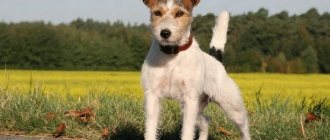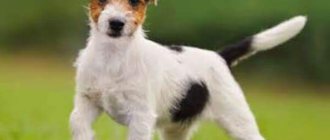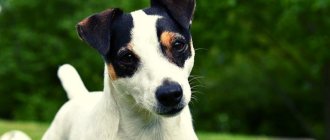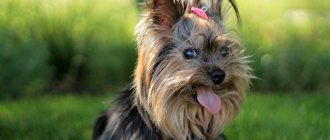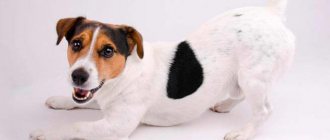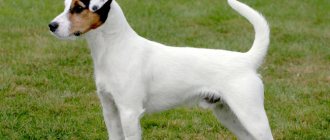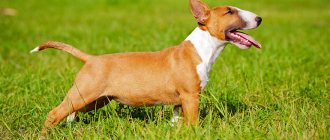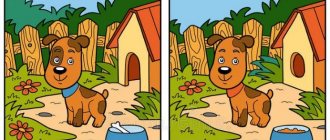Such a cute and harmless Jack Russell Terrier puppy captivates children from the first minutes of their acquaintance, and makes their parents, without hesitation, pay money to the breeder and take the pet home. But when this dog gets into the family, the new owners realize that they have acquired a real little devil. This small animal, without intensive training and strict upbringing, can destroy the entire apartment, and its character is a real test for the nerves of its owners. How to begin training a Jack Russell Terrier puppy, and how to properly raise a future adult dog, read our article.
Jack Russell Terrier: training a puppy
However, with proper upbringing, this irrepressible energy is easily channeled into a safe direction, and the little devil will become an obedient and cheerful pet.
Dog character
Among breeders, the Jack Russell Terrier breed is the most energetic of all dogs in the world. The character of the quadruped can be described as follows:
- A fan of adventure. A Russell puppy is ready all day long to come up with a way to misbehave so as not to get punished.
- Loves to dominate. Jack Russell Terriers are pack animals that always strive for the role of leader, including among people.
- Smart and cunning. Quickly finds the weak points of the owners and begins to manipulate them.
- Obedient and loving children. With proper upbringing, a puppy grows into a reliable friend who loves children and will always support.
Jack Russell Terrier puppies
Such a puppy needs a confident and energetic owner who can provide the pet with active walks and take on the role of a real leader. The puppy should feel the strength in its owner and immediately understand what is possible and what is not.
Someone who loves a quiet, relaxing holiday and prefers to stay at home should not get a puppy. A dog that doesn’t go all out on walks splashes out all its energy in the apartment. This behavior will be aggressive and destructive.
Important! Initially, the Jack Russell Terrier breed was considered a hunting breed, so without socialization it will begin to attack other animals and start fights. about the history and description of the breed in a special article on our website.
There is an opinion that beginners are strictly forbidden to have such a dog, but this is not entirely true. The Jack Russell Terrier is a medium-sized dog that cannot cause severe harm to a person, even if it starts to bite him. Even a beginner can test himself in raising her, with the support of an experienced trainer and remembering the important rules.
This dog breed was bred in England
What are the consequences of lack of education?
A Jack Russell Terrier, whose owners let their pet's upbringing take its course, can:
- bite, growl, attack guests;
- hunt small pets and even small children;
- chew all available objects and dig deep holes in the ground;
These dogs love to dig.
- arrange a toilet in any corner of the apartment;
- break off the leash, rage, jump;
- constantly howl when left alone at home;
- beg for food and steal “goodies.”
The owner’s task is to prevent all this uncontrolled disobedience of the pet. You can’t encourage your puppy’s pranks and be touched by his not entirely correct actions.
Preparation for the exhibition
First of all, it is necessary to bring the pet’s appearance to the standard and, if necessary, trim (pluck) excess fur. The dog must calmly withstand the examination by the judges: checking the teeth, joints (for males - the presence of both testicles). Nervous or aggressive behavior will result in disqualification.
Similar article: History of origin and description of the Jack Russell Terrier breed
You need to demonstrate a stance: the dog freezes in an “exhibition” position for 2–3 minutes. How to train a restless Jack Russell Terrier to do this? Make them spend more and more time immobile after the command “Ring!” (the “Stop!” command is not recommended for this). Praise and reward your puppy when he improves, but don't expect too much right away.
You also need to train the exhibition step in advance. The dog should walk next to your left leg. Movements should be smooth and free, with long steps. The dog's back should be straight, and its neck should be at an acute angle to the horizontal. Exhibition running takes place in a straight line and in a circle. The trot should be even and smooth. To train, run next to your dog while keeping him on a leash. Encourage the desired pace with your voice and stop jumping, speed failure, etc. with a jerk of the leash.
General recommendations for education and training
According to experienced trainers, Jack Russell Terrier puppies require a special approach:
- You shouldn’t shout at them or raise your hand, but you shouldn’t indulge in pranks either. For the puppy to understand that he did wrong, you just need to raise your voice and add severity to him.
- If the puppy has really seriously misbehaved, you can take him by the collar and shake him - this is how puppies are raised by their mothers.
- In education, you need to immediately establish a clear boundary, where the puppy is given the place of a subordinate, and the owner is given the role of leader.
You cannot encourage even the cutest pranks of your pet and be touched by it, otherwise they will develop into destructive games. These animals are very smart and immediately begin to twist the rope out of their owner as soon as he gapes.
Important! For training to be successful, you need to perceive Russell's emotions and state with caution and attention. You should not start classes after vigorous games or walks, or during illness. This breed is very attached to people, so it is important to treat your pet kindly and carefully.
Smooth Jack Russell with his favorite toy
Rules for successful training
In order for a puppy to grow into a sociable, friendly and well-mannered dog, the following rules must be followed when training:
- You need to accustom your pet to training at home. The first lessons last no longer than two minutes with a gradual increase in training time. There is no need to make the lessons too long: half an hour will be enough. Otherwise, the dog will get tired and she will no longer enjoy the activity;
- The sequence of actions is important: until the dog learns one command, you cannot move on to the second. The pet must not only learn to follow orders, but also understand what the owner needs. If he starts jumping from one command to another, the dog will quickly get confused;
- If the pet followed the command correctly, you should reward it: treat it with a piece of cheese or dry food, praise it, pet it. When giving a treat, do not extend your hand, but keep it closer to you. This way you can pet your pet while he eats, and the dog will quickly get used to your hands. He will associate them with delicacies;
The puppy should be encouraged
- commands should consist of one or two words so that the puppy remembers them easily. You need to teach commands step by step: from simple to complex;
- You need to start training before the main meal. After lunch, the puppy becomes lazy, and he doesn’t want to learn anything new;
- rudeness is completely prohibited, including shouting and assault. Even if the dog does not obey and does the opposite. The pet will begin to be afraid of the owner, which will definitely not bring success in training;
- It is recommended to end the lesson with a command that the puppy copes with successfully. After completing the task, be sure to praise your pet. This way, learning will be associated with a good mood;
- After each lesson, it is best to play with the dog to reinforce the pleasant association with training.
It is recommended to end the lesson with a game
Important! The order is given to the dog only once. After this, you need to wait until the puppy completes the command. If he is not going to do anything, you need to force him to carry out the order with guiding movements, showing him how to do it. You cannot reward a dog for not following a command.
Raising a puppy: where to start?
Immediately after the birth of a pet, new owners are tormented by three most pressing questions: how to accustom it to a diaper and a sleeping place, how to wean it from constantly barking alone, and how to accustom it not to bite. It is from these stages that the education of a small Jack Russell begins. In practice they look like this:
Table 1. Current problems of small Jack Russell Terriers and their solutions
| Problem | Accustom to a diaper | Learn to sleep on a lounger | Stop whining and howling loudly when alone | Stop biting hosts and guests |
| Solution | Taking the puppy to the diaper:
| When the pet gets tired of active games and lies down in the middle of the room, the owner sternly tells him: “Place” and takes him to his bed. If the baby runs away and begins to spin around under your feet, the command should be repeated in a more threatening tone and take the puppy back. | The owner leaves the room for a few minutes, gradually dividing the care for longer periods. You can return only when the baby stops barking. Otherwise, he will get used to the fact that loud barking can bring back his owner. | The owner must show that he is in pain by screaming loudly after the bite and running out of the room. You can also distract the puppy: when he starts biting, throw his favorite toy next to him. |
| Result | There is no need to walk with the puppy when this is impossible: for example, during a thunderstorm or severe frost. | The pet quickly gains independence, and caring for it becomes easier. | The baby will be able to safely stay at home alone without harming the neighbors' hearing. | Instead of attacking family members, the little “Russell” begins to bite his toys more actively. |
Nuances:
- You should not scold the puppy while urinating or in the process of defecation, this will cause behavior disorder;
- the puppy needs to be praised if he relieves himself in the designated place;
- diaper training does not completely free you from walking your dog; walking can only be avoided in extreme situations;
- the desire to bite the owner may indicate a desire to play, and not aggression, so there is no need to label a biting puppy as an angry dog;
- During teething or teething, the puppy should be given toys and bones to relieve itching from the gums.
From the very first days, you need to teach your baby not to play with shoes and other things. The pet should have enough of its own toys - they buy balls, ropes, and bones so that there is no temptation to bite into a book or pillow.
Two puppies playing with a ball outside
Keeping and feeding a puppy
For the puppy, you need to select and arrange a place where he will sleep. You need to find a permanent place for a bed in your apartment. The bed should be of a suitable size so that the dog can fully fit on it, not too soft or hard, and covered with natural fabric.
Jack Russell Terrier, wire-haired and smooth-haired
In addition to the sleeping place, it is important to take care of a place for the enclosure in case the owners are absent. It should be equipped with a thick mattress and a bowl of water. It is recommended to leave several dog toys so that the puppy can play independently without damaging home furnishings or shoes.
Note! The Jack Russell Terrier is an active breed, so the puppies run a lot, are constantly on the move, and love to jump. If the apartment has several floors, you need to limit his movement along the stairs. After all, a puppy has rather fragile bones that can break easily.
For healthy development, a puppy requires a balanced diet, including the required amount of proteins, fats, carbohydrates, minerals and vitamins.
Initially, it is better to feed a small Jack Russell the same food that he was fed by the breeder, so as not to cause digestive problems. Often, the nursery provides puppies with good quality dry food. To switch to natural food, it is important to introduce foods suitable for the pet’s age into his diet every day for several weeks.
Important! It is strictly forbidden to give food and natural food at the same meal.
The basis of a natural diet should be meat, vegetables and cereals. When feeding, you need to take into account the recommended proportions of 2:1:1.
If the puppy is 1 month old, you can give dairy products, but at an older age it should be excluded, because the breed is lactose intolerant.
Toilet training
Raising a small puppy begins from the first months of life. The first toilet for a puppy is a diaper, because without vaccinations it is dangerous to take him outside. To teach the puppy to relieve himself on it, you need to put it in a diaper every time he starts fussing around in search of a comfortable place. This way he will quickly remember where his “toilet” is.
To quickly train your pet to use the toilet outside the home, you need to follow these tips:
- You need to take the dog out for a walk after 5-10 minutes. after eating food. In addition, when the dog wakes up, you need to immediately go outside with him;
- if the puppy is not yet 6 months old, it needs to be walked every 2-3 hours. Frequent walks will help quickly accustom the four-legged dog to defecation on the street. After 6 months, walks are reduced to 2-3 times a day; their number should be reduced gradually;
- If in the apartment the dog begins to behave fussily, sniffing the floor, looking for the right place, you need to take him outside as quickly as possible.
Several techniques to help train your dog to go to the toilet outside the apartment:
- After bowel movements, the puppy needs to be praised;
- treat dog treats;
- play with your pet.
Note! After such simple actions on the part of the owner, the dog will understand that his behavior evokes positive emotions in the person, and that after this he is treated and praised. The dog will try to evoke such emotions every time.
Teaching first commands
After the puppy has acquired the basic skills, it’s time to learn the simplest commands. The Jack Russell baby is ready to train at the age of 6 weeks. The commands you should start training with are presented in the table below along with the age at which they are easiest to learn.
Table 2. Study of commands from 6 weeks to 6 months of age
| Puppy age | Team | How to train |
| 6 weeks – 2 months | Puppy's name | The nickname should be called every time you contact your pet and rewarded if he responds to his name |
| 2-3 months | "To me!" | The owner shows the dog a treat held in his palm and calls him to him with a gesture |
| 3-3.5 months | "Lie!" | The treat is placed in front of the dog. If she does not lie down, gently help her by pressing on the croup. |
| 3.5-4 months | "Ugh!" | The owner says “Ugh!” when the puppy grabs garbage from the ground while walking. In case of disobedience, the command is repeated more strictly. If during a walk your pet wanders off to the side, you need to say “Ugh!” and pull the leash towards you |
| "Sit!" | The trainer holds a piece of treat above the puppy's head so that he can notice it only after he sits down. | |
| 4-6 months | "Near!" | During walks, the puppy is kept on a leash near the owner's left leg. At first they teach to sit and stand next to the owner, and then |
It is recommended to learn no more than two commands in one lesson. Each order must be repeated constantly so that the puppy does not forget the commands. This course is designed so that the child gets used to training gradually - from simple commands to complex ones. A new command should be given to the pet to study after the previous one has been reinforced.
Important! After the owner has shown the pet the action for the command and announced its name, nothing can be changed. Otherwise, the puppy will get confused and will not follow orders.
At what age should you start?
Training begins after the puppy is 6 weeks old. Your child needs to be taught according to a special program that will allow him to consolidate his knowledge and enjoy the game.
Jack Russell Terrier: care and maintenance at home
An approximate program for training and training a Jack Russell Terrier at home on your own:
- from 6 weeks to 4 months they are taught to respond to a nickname;
- from 2 to 3 months they learn the command “come to me”;
- from 3 to 3.5 months - the commands “sit” and “lie down”;
- from 3.5 to 4 months - “stand”;
- from 4 to 6 months - commands “forward”, “wait”, “show your teeth”, “fetch”;
- after 6 months, they teach the dog to behave in public places, with large crowds of people, and also learn the commands “voice”, “crawl”, “walk”;
- at the age of 1 year, the dog is taught to find the owner by smell, follow the scent, overcome obstacles, not trust strangers and not accept treats from their hands.
Note! For each success, the puppy is treated to a treat. This will help motivate him for further success. After a year, the dog will reach “coming of age”, and then the training process can be considered complete.
Puppy training begins at 4 weeks
Continuation of training (4-6 months)
The dog should know a basic course of basic commands by 6 months. Having taught the pet the commands from the previous paragraph, the owner proceeds to the following:
- “Show your teeth!” The owner says: “Show your teeth,” while placing his right hand on the lower jaw, and his left hand on the upper jaw. Unclenches lips, not allowing jaw to move apart;
- "Voice!". When the pet starts barking, the owner says a command and praises the pet. After several repetitions, the pet will get used to it and begin to bark on command;
- "Walk!". Most often used as a reward after completing other commands. It’s easy enough to pat your pet on the back, say “walk” and let him go;
- "Stand!". The owner brings the pet to him, pronounces the command, pushes him a little under the stomach so that he stands and listens. After this, reward with a treat. If the dog lies down, pick it up by the fur. After completion, release the dog with the command “Walk!”;
- “Crawl!” This is a rather difficult exercise, as it involves a large number of muscles that are not used in everyday life. This command can be learned after an emotional connection has already been formed between the owner and the dog. The owner orders the pet to lie down, and he squats in front of him, holding his hand with a treat close to the ground. After the command “Crawl!” the pet should gradually crawl towards the owner. When he crawls about 20 cm, you should reward the dog. With each lesson the distance increases;
This is how the command “Crawl!” is executed.
- "Forward!". It is practiced on the street near a narrow passage. The owner approaches a ditch/hole/narrow stream and throws a wide board over it. The owner gives the dog standing nearby a treat to sniff, then commands “Forward!” and throws the treat, throwing out his hand, palm down. When the dog runs for a piece and finds it, it is rewarded with a gentle voice and a second piece of treat;
- "Wait!" Having learned the command, the pet will be able to remain motionless until ordered to leave. The owner calls the pet to him, orders him to sit or lie down, after which he commands “Wait!” and holds it with his hand. After a couple of minutes, give the dog a treat and command “Walk!”;
- Also at this age it is time to teach the puppy to give the object clenched in his teeth to the owner when he asks. This is done with the command “Give it back!”, after which you need to carefully take the thing and press the dog to the ground with both hands - by the head and croup. This way he will quickly get used to discipline and understand who is in charge in the family.
Jack Russell Terrier plays frisbee with owner
Getting used to walking
You can start walking your Jack Russell Terrier 2 weeks after the second vaccination, i.e. at approximately 10-11 weeks of life. By this time, the baby’s immunity will be significantly stronger, and his body will no longer be dangerous from many of the diseases that lie in wait for the terrier on the street. At first, the baby is walked about 5-6 times a day, preferably as the dog gets ready to go to the toilet at home.
The main goals of walking at this age:
- it is necessary to teach the dog not to be afraid of the street;
- the animal must learn that they no longer go to the toilet at home;
- Socialization is the first interaction with other dogs.
When walking your puppy, remember: at first you need to choose places where there are no cars, no wide roads, and no large number of people or other pets.
As soon as your baby stops being afraid of the street and can safely run some distance away from you, start introducing him to the leash. After some time, you can go out into society and meet other dogs. It is advisable to limit contact with pets that are too large and active, as they can frighten the baby. An adult dog should walk no more than 2 times a day, but the terrier needs to be transferred to this walking plan gradually, reducing the number of walks every 1-2 weeks.
Final teams (6-8 months)
When the baby is six months old, it’s time to teach him how to behave in crowds and on public transport. At the same time, already learned commands are reinforced. So, the final set of commands and the learning process for them looks like this:
Table 3. Training the Jack Russell Terrier to commands at the age of 6-8 months
| Team | How to teach? |
| Jumping over barriers | Pick up a stick, branch or pull a rope. Stand on the other side, show your pet a treat and beckon it to you. When the pet jumps or steps over, give a “yummy”. Gradually the height of the barrier needs to be increased |
| Moving in crowded places | Walk your dog on busy streets more often, starting with the least crowded places. Gradually, the pet will no longer be afraid of crowds of people and cars passing by. |
| Riding on public transport | It happens gradually. First, the pet is allowed to get used to the stops by walking nearby and gradually approaching. Then it is recommended to choose a time when there will be fewer people on the bus/tram and go there with your pet. The first time it is better to carry it in your hands. After the second and third trip, the pet will get used to the transport |
| Following the trail, the command “Search!” | Take the owner’s thing, let the dog smell it, then hide it and command “Search!” If she finds the wrong thing, say “Ugh” and repeat the command. Praise after the dog finds the desired item |
Active games continue, during which the commands “voice”, “walk”, “crawl”, “next” and others are trained. New teams are gradually being added to them. In addition, a six-month-old puppy should already be able to find its owner by smell. However, you should not endlessly train your pet; you should take breaks between classes. The baby's growing body is not yet strong enough for such stress.
At the same time, already learned commands are reinforced
Important! At this age, it is necessary to instill in your pet distrust of strangers. He must refuse food given to her by a stranger.
Accustoming to accessories
Most Jack Russell Terrier owners stop at teaching their puppies simple commands and instilling obedience in them. However, animals that are being prepared for exhibitions or frequent travel require additional training: developing the habit of sitting in a cage and getting used to a muzzle.
Dog in a muzzle
The latter is instilled in the animal during puppyhood. The process occurs gradually according to the following algorithm:
- a muzzle is given to the baby so that he can sniff an unfamiliar object and make sure it is safe;
- a favorite treat is placed inside the muzzle so that the terrier, reaching for it, completely immerses his muzzle;
- the owner makes sure that the pet does not take food bypassing the muzzle;
- immediately after the terrier reaches for the piece, a second one is placed in the muzzle so that the baby keeps his muzzle in it longer;
- the second piece of treat is added at each training session at a different time interval;
- after 7-8 seconds of the baby being in the muzzle, the clasp is snapped and then immediately unfastened;
- at the next stage of training, a treat is given after putting on the muzzle;
- the final stage - they put a muzzle on the dog and go for a walk, preventing attempts to remove it.
After finishing the walk, the owner removes the muzzle himself while the pet is distracted by playing or something else.
Jack Russell waiting for a walk
Training for exhibitions
To prepare a puppy for exhibitions or some kind of show, he must be taught the commands “near”, “sit”, “show teeth”. In addition, it is very important to instill in the animal the habit of sitting in a cage without worry or fear. This training is carried out according to the following algorithm:
- The cage or carrier is opened and a piece of your favorite treat is placed in it - hard cheese or dry food. The dog is given the opportunity to pick it up.
- The procedure is repeated several times. When the puppy begins to fully enter the crate, he is praised and rewarded with a treat.
- At the next stage, the puppy must enter an empty crate, and the treat is given only after he is completely there and spends a few seconds.
- The owner must not interfere with the pet leaving the carriage. The dog can go out whenever he wants.
- When the pet comes inside the cage, stops and freezes, he is praised and rewarded with treats the entire time he is there.
- Then the owner gives the command “Lie down!”, after which he praises the pet and gives a treat.
- When the dog begins to feel confident in the crate, the door is closed and immediately opened. The pet is given a treat.
- With each training session, the time the animal spends inside the cage with the door closed increases. But at any sign of uncertainty, the “jack” is allowed to come out.
Jack Russell Terrier in a cage for transportation
Accustoming to transportation should be carried out in a measured and comfortable environment for the baby, despite the fact that the process can last from 3 to 5 days. It is very important to choose the right carrier or cage. The height of the cage is calculated according to the formula: pet’s height + 10-15 cm, and the body of the “jack” along with the owner’s hand should fit into the open door without any problems.
Raising a show dog
Training for hunting
The Jack Russell Terrier breed was originally intended to be a hunting dog, so some owners buy a terrier specifically for this purpose. In order for a pet to become a good hunter, it is necessary to initially accustom it to the sounds of gunshots so that the assistant does not get scared and run away in the most critical situation.
A wonderful representative of burrowing hunting dogs
Training occurs according to the following scenario:
- It is necessary to find an accomplice who will be assigned to shoot the scarecrow. Initially it is located about 150 meters from the dog walking area.
- The owner goes for a walk with the dog, starts playing with it, talking affectionately and praising it for following simple commands. At some point, the owner gives a sign to his assistant, unnoticed by the dog, and he shoots.
- After the shot, the pet should become alert and turn towards the unfamiliar sound. The owner continues to play with the dog as if nothing had happened.
- After a few minutes, the distance to the assistant with the weapon gradually decreases, and the shot is heard again. At this time, you need to look at the pet’s reaction: if the dog gets scared, starts to break from the leash and tries to run away, you cannot scold it. On the contrary, you need to pet him, calm him down and go home.
- The training is repeated after 3-4 days. The dog will be ready for such sharp sounds and will behave calmer.
After a few lessons, you will be able to achieve the usual reaction of a hunting dog: when fired, it will turn in the direction of the sound, prick up its ears, and at any moment, on the orders of its owner, will rush in pursuit.
Grown-up Jack Russell Terrier on the hunt
What is forbidden to do during training?
80% of the success in training a puppy depends on the severity of the owner and his ability not to react to the puppy’s pleading look. During training, you should never:
- feel guilty when prohibiting your pet from doing anything. Love should not be confused with discipline. If you forbid something, forbid it with all severity, and praise only when the commands are carried out correctly;
- allow the puppy to sleep even for a short time outside the house, bed or rug. It is not recommended to allow the dog to sleep on the owner’s bed if the owner does not want the dog to constantly get between the spouses at night;
- Allow the puppy to rise above the owner, placing his paws on his chest. Usually such cases occur during games on the floor. Once you play with your pet like this several times, he will imagine himself to be a boss and completely stop obeying his owner;
The puppy is forbidden to rise above the owner, placing his paws on his chest
- Allow Jack to sit on pieces of furniture whenever he wants. It is necessary to accustom the pet to the fact that only the owner decides when the baby is allowed to climb onto the bed/chair/sofa, and when it is prohibited;
- Allow the puppy to ride in the front seat of the car. To transport dogs, there are special seats with straps that are attached to the driver in the car. Otherwise, the pet will quickly turn into a second driver: an active dog will put its paws on the steering wheel and help steer.
You cannot respond to begging, as Jack Russell Terriers love this activity very much. Even if there is food left on the host’s table after some holiday, you should not give in to temptation. Otherwise, the family’s quiet lunches and dinners will turn into an eternal struggle with the puppy, who will beg in every way for “yummy food.”
A puppy can beg for a “yummy treat” in any way possible.
General training course
The general dog training course (GTC) is a system developed by Russian dog trainers. It allows you to develop certain conditioned reflexes in your pet and instill skills of exemplary behavior. Dogs undergo OCD together with their owners, and the trainer serves as a teacher for both of them.
Important! You can start learning OCD in your Jack Russell Terrier from the age of four months. I will also use these exercises to train an adult dog, if the owners have not trained before.
Video - Training and education of Jack Russell Terrier dogs
What will you need to take the course?
To successfully complete the course, the owner should stock up on ammunition. This:
- soft wide collar to fit the dog's neck;
- fabric/leather leash 2-3 cm wide and at least 2 meters long; chains, laces or leashes with tape measures will not work;
- a muzzle to fit the pet's muzzle, a rug, a toy or a stick for throwing;
- a treat to encourage the student, located in a separate fanny pack or other convenient place.
Important! As a treat, you should not choose food that the animal eats daily. You need to choose something especially tasty - dried meat, offal, cheese cubes. This should be your pet's favorite treat.
Jack Russell Terrier Games
What will a dog learn from OKD?
After completing the training course, the Jack Russell Terrier will learn general commands that will be useful to him in life. He will become less eccentric and learn to channel his energy in the right direction. Training will teach your pet:
- put on and take off the muzzle without fear;
- find an item abandoned by the owner using the command “Fetch!” and give it into your hands after the order “Give!”;
- demonstrate a clenched jaw at the command “Teeth!”;
- perceive the command “Fu!” even when the dog’s favorite food is in front of him;
- stand, sit, lie still, crawl;
- lie down on the mat if given the command “Place!”;
- without reacting to external stimuli, approach the owner after the order “Come to me!”;
- jump over fences and obstacles on the command “Barrier!”;
- after the command “Near!” be near the owner: the pet must move in step with him or, without orders, sit next to him if he stands still;
- do not be afraid of loud sounds: the training is carried out using a scarecrow, the shots of which the dog quickly gets used to.
After completing the training course, the Jack Russell Terrier will learn general commands that will be useful to him in life.
Additionally, the pet learns the “walk” command, which is used as a reward: the animal is given time to take a break from training and socialize with other dogs.
How does OKD work?
Classes in most cases are group: this is how each pet begins to learn how to behave correctly in society, and the owners monitor and control the behavior. Each training session lasts no more than two hours. The trainer first performs new exercises with the animals, after which the students rest a little, and the repetition of already learned commands begins. The number of exercises in each training session is increased gradually so that the dogs do not overexert themselves. This way, pets do not lose interest in learning until the end of the course. Classes for adult dogs, if they have not experienced the course as a puppy, are more intense, and the requirements for following commands are higher.
Adults participate in agility
You can read more about agility here .
In rare cases, a course of training may have no effect on the pet's behavior. He can't learn any commands and continues to misbehave. In such difficult situations, it is recommended to take an individual training course.
Important! If a Jack Russell has problems with joints or ligaments, or has heart disease, he will need to adjust his training program to suit his condition. The trainer will do this. Otherwise, there are no contraindications to OKD.
How to stop biting
The hunting blood of the Jack Russell Terrier breed does its job: the dog moves a lot, often plays and in a fit of fun cannot control itself. The result is the owner’s bitten hands and, possibly, torn trousers. If the puppy clearly begins to go too far, all his games result in biting and hunting for the legs or sleeves of the owner’s clothes, then it’s time to think about training.
You cannot forgive a dog for such behavior, otherwise in the future it will be able to bite its owner without the slightest remorse if it doesn’t like something. By 4-5 months, the problem usually becomes obvious. Start by limiting play that involves your dog's contact with your hands, using toys, and not allowing children to provoke the animal.
It is necessary to develop the “bite = unpleasant sound or blow” reflex in the dog. But the blow here does not mean brute force, but, for example, grabbing the muzzle with your fingers so that the animal cannot open its teeth. Take care of your animal's health! If you press hard on the nose, it can cause terrible pain to the puppy! Reprimand your dog, but don't yell at it or scare it.
Maintenance and care of the Jack Russell Terrier
Raising a four-legged animal is not limited to just learning commands. It is important to instill in him love or at least a calm attitude towards care procedures. The Jack Russell Terrier needs to be groomed in the same way as other short-haired breeds, paying special attention to the ears, teeth, eyes and coat.
Wool
Most representatives of this breed have coarse and short hair that is capable of self-cleaning. Those who do not want to regularly care for their fur should buy individuals with smooth hair. To prevent your puppy from leaving shed fur all over the house, you need to regularly remove dead hairs with a brush or a special mitt. You need to comb your pet every week using a wide-toothed comb.
Walk in the forest belt
The coat must be inspected every time after walking in the forest or in parks for the presence of ticks, fleas and other insects. You can use a flea collar and insect repellent as a preventive measure. There is no need to wash the dog often: this is done once a month, and also before an exhibition or an important event.
Eyes
You should regularly wipe your pet's eyes with a cotton pad soaked in weak tea leaves. This will help prevent the development of inflammation . You can also use a special solution from the pharmacy.
Teeth
It is recommended to brush your teeth at least 2-3 times a week, using a special dog paste and brush. To prevent tartar from forming in your dog's mouth, you should include some tomatoes in your diet.
Special kit for dog dental care
Ears
The ears require constant inspection. Once a week they should be carefully wiped with a damp cloth, without touching the membrane.
You can read more about dog ear diseases here.
Claws and paws
After each walk, your pet’s paws must be washed or wiped well with a damp cloth. Claws are trimmed using a special nail clipper no more than 1-2 times a month. Since this is a very painstaking and dangerous procedure (if you touch the blood vessels, severe bleeding will begin), it is better to entrust it to a specialist.
Jack Russell Terrier walks with its owner near the water
Video “Training and raising Jack Russell Terrier dogs”
From this video you will learn interesting facts about the Jack Russell Terrier breed.
Recommended Posts
History of origin and description of the Jack Russell Terrier breed
The main pros and cons of the Jack Russell Terrier breed
How to choose a healthy Jack Russell Terrier puppy
Description of the breed and everything about keeping the Parson Russell Terrier
Independent training and education of the Staffordshire Terrier
Raising and training the Yorkshire Terrier

